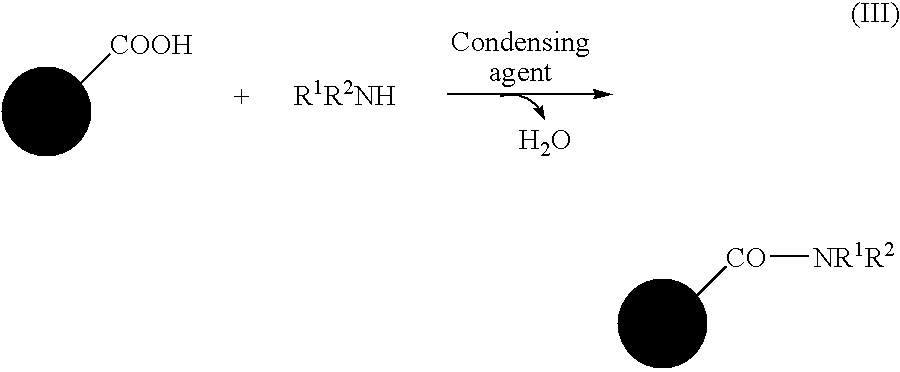Aqueous dispersion of surface-treated carbon black and method of producing the same
a carbon black and surface-treated technology, applied in the field of surface-treated carbon black aqueous dispersion, can solve the problem that the water medium cannot be used as the reaction solvent, and achieve the effects of reducing side reactions, excellent image density, and high-quality images
- Summary
- Abstract
- Description
- Claims
- Application Information
AI Technical Summary
Benefits of technology
Problems solved by technology
Method used
Image
Examples
example 1
[0078]Carbon black (“Seast 9H” manufactured by Tokai Carbon Co., Ltd., specific surface area by nitrogen adsorption: 142 m2 / g, DBP absorption: 130 cm3 / 100 g, pH: 6.0) was oxidized with ozone for 8.5 hours at a pressure of 0.02 MPa and a flow rate of 5 l / min using an ozone generator (“CO-101” manufactured by Yamato Scientific Co., Ltd.). After the addition of purified water, the mixture was stirred to prepare a slurry having a carbon black concentration of 5 wt %.
[0079]The carboxyl group content and the hydroxyl group content of the oxidized carbon black were measured using the following methods, and found to be 560 μmol / g and 118 μmol / g, respectively.
[0080]About 2 to 5 g of the oxidized carbon black was added to a 0.976 N sodium hydrogen carbonate aqueous solution. The mixture was shaken for about 6 hours, and filtered. The carboxyl group content was measured by titration.
[0081]2,2′-Diphenyl-1-picrylhydrazyl (DPPH) was dissolved in carbon tetrachloride to prepare a 5×10−4 mol / l solu...
example 2
[0083]Carbon black (“Seast 9H” manufactured by Tokai Carbon Co., Ltd.) was oxidized with ozone for 8.2 hours at a pressure of 0.02 MPa and a flow rate of 5 l / min using an ozone generator (“CO-101” manufactured by Yamato Scientific Co., Ltd.). After the addition of purified water, the mixture was stirred to prepare a slurry having a carbon black concentration of 5 wt %.
[0084]2.75 g of a 10 wt % aqueous solution of ethanolamine (Mw: 61.08), 40.7 g of a 10 wt % aqueous solution of benzylamine (Mw: 107.15), and 11.1 g of DMT-MM (triazine condensing agent) (powder) were added to 1 kg of the slurry. The mixture was stirred at room temperature for 20 hours. The resulting dispersion was centrifuged at 6000 rpm to remove large particles. The supernatant liquid was subjected to ultrafiltration, purification, and concentration to obtain an aqueous dispersion having a carbon black concentration of 15 wt %.
example 3
[0085]Carbon black (“Seast 911” manufactured by Tokai Carbon Co., Ltd.) was oxidized with ozone for 7.5 hours at a pressure of 0.02 MPa and a flow rate of 5 l / min using an ozone generator (“CO-101” manufactured by Yamato Scientific Co., Ltd.). After the addition of purified water, the mixture was stirred to prepare a slurry having a carbon black concentration of 10 wt %.
[0086]1.5 g of a 10 wt % aqueous solution of bis(2-methoxyethyl)amine (Mw: 133.19), 6.4 g of a 10 wt % aqueous solution of N-benzylethanolamine (Mw: 150.22), 37.5 g of a 10 wt % aqueous solution of benzylamine (Mw: 107.15), and 11.1 g of DMT-MM (triazine condensing agent) (powder) were added to 1 kg of the slurry. The mixture was stirred at room temperature for 20 hours. The dispersion was centrifuged at 6000 rpm. The supernatant liquid was subjected to ultrafiltration, purification, and concentration to obtain an aqueous dispersion having a carbon black concentration of 15 wt %.
[0087]The dispersion was subjected to ...
PUM
| Property | Measurement | Unit |
|---|---|---|
| specific surface area | aaaaa | aaaaa |
| solubility | aaaaa | aaaaa |
| solubility | aaaaa | aaaaa |
Abstract
Description
Claims
Application Information
 Login to View More
Login to View More - R&D
- Intellectual Property
- Life Sciences
- Materials
- Tech Scout
- Unparalleled Data Quality
- Higher Quality Content
- 60% Fewer Hallucinations
Browse by: Latest US Patents, China's latest patents, Technical Efficacy Thesaurus, Application Domain, Technology Topic, Popular Technical Reports.
© 2025 PatSnap. All rights reserved.Legal|Privacy policy|Modern Slavery Act Transparency Statement|Sitemap|About US| Contact US: help@patsnap.com



